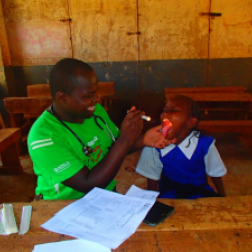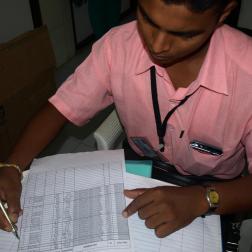The Global Burden of RHD – Q&A with David Watkins

Dr. David Watkins is an internal medicine physician and health systems researcher who works with the Disease Control Priorities Network at the University of Washington in Seattle. He is also part of RhEACH at the University of Cape Town and is a collaborator on the Global Burden of Disease project. He is joining us today to talk about global prevalence and mortality from rheumatic heart disease (RHD), as well as recent advances in RHD epidemiology.
First of all, how would you define ‘Burden of Disease’?
There are several different measures that people refer to when they talk about disease burden. First, there are fatal outcomes, like levels of overall mortality, deaths due to specific causes like RHD, and life expectancy. For ethical, political, and economic reasons, it’s extremely important to measure mortality correctly – especially diseases like RHD that kill children and working age adults. Second, there are nonfatal outcomes, like incidence, prevalence, and disability. These are critical factors to consider for health system planners, who need to know how to allocate healthcare resources based on need.
Third – and this is a unique aspect of the Global Burden of Disease work – there are so-called “summary measures of health” such as years of life lost, years lived with disability, and disability-adjusted life-years (or DALYs). These measures convert the “natural” outcomes (deaths, cases of disease) into common units that can be compared across diseases.
The Global Burden of Disease studies produce all these measures for RHD as well as for 250-300 other important causes of health loss globally. The advantage GBD has in producing RHD estimates is that they are internally and externally consistent and fit with the overall pattern of disease in the world. This standardization and enforced consistency are critical if we ever hope to track our progress on RHD – and other diseases.
What are the primary sources of data that are used to estimate the global RHD burden?
The GBD studies strive to use all available data from around the world to produce their estimates of RHD burden. Estimates of fatal outcomes come from a combination of demographic methods, which give us the number of deaths from all causes, and analysis of vital registration data, which give us the rates of specific causes of death like RHD. We also use a chronic disease epidemiological modeling tool, DisMod, to fill in gaps for countries without their own prevalence data.
How much RHD is there in the world?
The figure differs depending on which metric you use. Take prevalence for example: GBD 2015 estimated that there were 33 million people living with RHD worldwide, about 0.45% of the world’s population. However this number varies widely by region and country. For instance, estimated prevalence ranges from 0.01% of people in Western Europe, to 1% in central sub-Saharan Africa and 1.5% in the Pacific Islands.
If you're talking about deaths, the GBD 2015 study estimated that RHD was responsible for 320,000 deaths. Most of these are in low- and middle-income countries, but we shouldn’t forget that every year there are probably about 34,000 people who die of RHD in high-income countries.
The World Health Organization (WHO) also produces estimates of mortality from RHD, using slightly different methods. Nevertheless, they estimated about 340,000 deaths from RHD in 2012, which is – all things considered – quite similar to our estimates in the GBD 2015 study.
What are the challenges of tracking rheumatic heart disease?
On the mortality side, there aren’t good vital registration data for most African countries, which means studies like GBD have to use sophisticated modelling approaches. These allow us to produce estimates based on correlated indicators that are available, such as income, sanitation, and malnutrition.
However, this does mean that GBD estimates of deaths from RHD in these countries have wider uncertainty intervals, and this makes it harder to detect significant increases or decreases in mortality rates. That problem won’t get better until governments invest more in disease surveillance and health system strengthening. On the prevalence side, the challenge is that many researchers are doing the same study, whereas what we really need is more diverse science.
What kinds of additional studies are needed?
Well for instance, there are scores of studies of RHD in schoolchildren, but only one that I know of that looks at RHD in the community, where it was found to be more frequent. We also have some evidence that RHD is more common in rural areas, but I don’t know of any studies that have systematically compared the prevalence of RHD in different geographic regions across a country.
Finally, there are only a couple of studies estimating the prevalence of RHD in working-age adults, who appear to be the vast majority of cases in most countries. My recommendation to the echo-screening community is to start screening adults, and also to build partnerships with experts in population surveys to generate better, more representative datasets.
Why is data so important to RHD prevention and control?
Data are crucial for a number of reasons: first, data are important for tracking progress and ensuring accountability. If the data suggest RHD mortality is not declining in a country, then a programme is not working and needs to be revised. Good prevalence data are also required for health system planning. For example, this includes ensuring adequate supplies of benzathine penicillin G – the antibiotic used for primary and secondary prophylaxis – which has been a problem recently in a lot of countries.
Perhaps most important, however, data are the foundation for implementing interventions. If we understand the scope of the problem, and then successfully bring those data to key stakeholders and policy makers, we stand a better chance of convincing them to act.
It’s not like we don’t have effective interventions for RHD. From a ministry of health standpoint, this disease can be a “quick win” – we can achieve a drastic reduction in the rates of rheumatic fever in most countries within a decade or so if there is a real commitment.
Find out More
For more information about the global burden of RHD, and what’s being done to prevent it, visit the interactive RHD Atlas.





